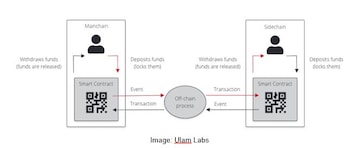
Since its inception, blockchain technology has always struggled with the issue of scalability. For a transaction to be confirmed, several nodes on the network must arrive at a consensus regarding its validity. This works fine until traffic on the network begins to increase. Then nodes become overworked, resulting in a bottleneck of transactions and delayed confirmations.
If we were to try and speed up transactions (improve scalability), we would have to compromise on the security or centralisation of the blockchain. However, since these take precedence over scalability, we end up with slow blockchains, like Bitcoin, which can only process five transactions per second (TPS). That’s sluggish compared to Visa’s 24,000 TPS. This is where sidechains come in.
Sidechains are independent blockchains designed to address the issue of scalability. They work in parallel with the main blockchain and reduce its transaction load. They communicate with the main blockchain or ‘parent blockchain’ through a ‘two-way peg.’ The two-way peg ensures that the data remains synchronized between both chains at all times (more on this later).
Also Read:
Using this two-way peg, we can reroute the processing power out of the main chain and onto the sidechain. This reduces transactional load and improves the scalability of the main chain.
Let’s see how this works.
Firstly, sidechains have their own nodes and are designed to be more centralised. This might pose a security risk, but it is limited to the sidechain itself and does not put the mainchain in any danger. The sidechain can also have its own consensus mechanism, which could be different from the main chain. Moving on.
Before a user can begin transacting, he has to lock in funds through a smart contract on the sidechain. An off-chain process scoops this up, creates an ‘event,’ verifies it, and transmits it to the main chain via the smart contract and the peg.
When the main chain confirms the existence of this validated event, it broadcasts the information all over its network. This is when the nodes acknowledge it and tell the blockchain to lock the mentioned amount of BTC on the network.
The peg then relays the update to the smart contract on the sidechain, which releases a proportional value in its native tokens to the user. So, an actual asset exchange never occurs. A specific value of assets is blocked on one blockchain, and an equivalent value worth of tokens is released on the other. Once this is done, the smart contract gets updated and closes the event.
Here’s an illustration of the same.

The smart contract plays a very critical role in this process. It is the only thing that enforces the blockchains on both ends to behave honestly and ensure a fair transaction. Only when the smart contract communicates to both chains that impartial validation is done are the tokens blocked and released, respectively.
The effect on scalability:
The Lightning Network is an example of a sidechain network connected with the Bitcoin blockchain. Here's how it works: Two transacting parties commit (lock-in) an amount of BTC to the Lightning Network. After this, they can make as many transactions as they like within the amount of BTC they have committed.
The Lightning Network creates a channel between two transacting parties. Once this channel is established, the two parties can instantly send BTC to one another at minimal costs. These transactions are not transmitted to the Bitcoin blockchain.
Once the parties conclude their transactions, the channel is closed. The final amounts are sent to the participating parties as per the transfer history recorded on the channel - this is the only transaction stored on the Bitcoin blockchain.
Therefore, as you can see, the Lightning Network sidechain greatly reduces the amount of transactional data transferred to the mainchain. This helps improve the scalability of the Bitcoin blockchain. Similarly, there are several such sidechains, each with its own unique functions and features. Rootstock is another example of a Bitcoin sidechain, whereas Polygon is an example of an Ethereum sidechain.
Check out our in-depth Market Coverage, Business News & get real-time Stock Market Updates on CNBC-TV18. Also, Watch our channels CNBC-TV18, CNBC Awaaz and CNBC Bajar Live on-the-go!


Visiting temples, obliging selfie requests, jabbing rivals – Kangana Ranaut is wooing voters on campaign trail
May 5, 2024 8:23 PM
Election Commission grants shifting of 7 polling stations in Kullu, Mandi, Shimla and Kinnaur
May 5, 2024 6:50 PM

